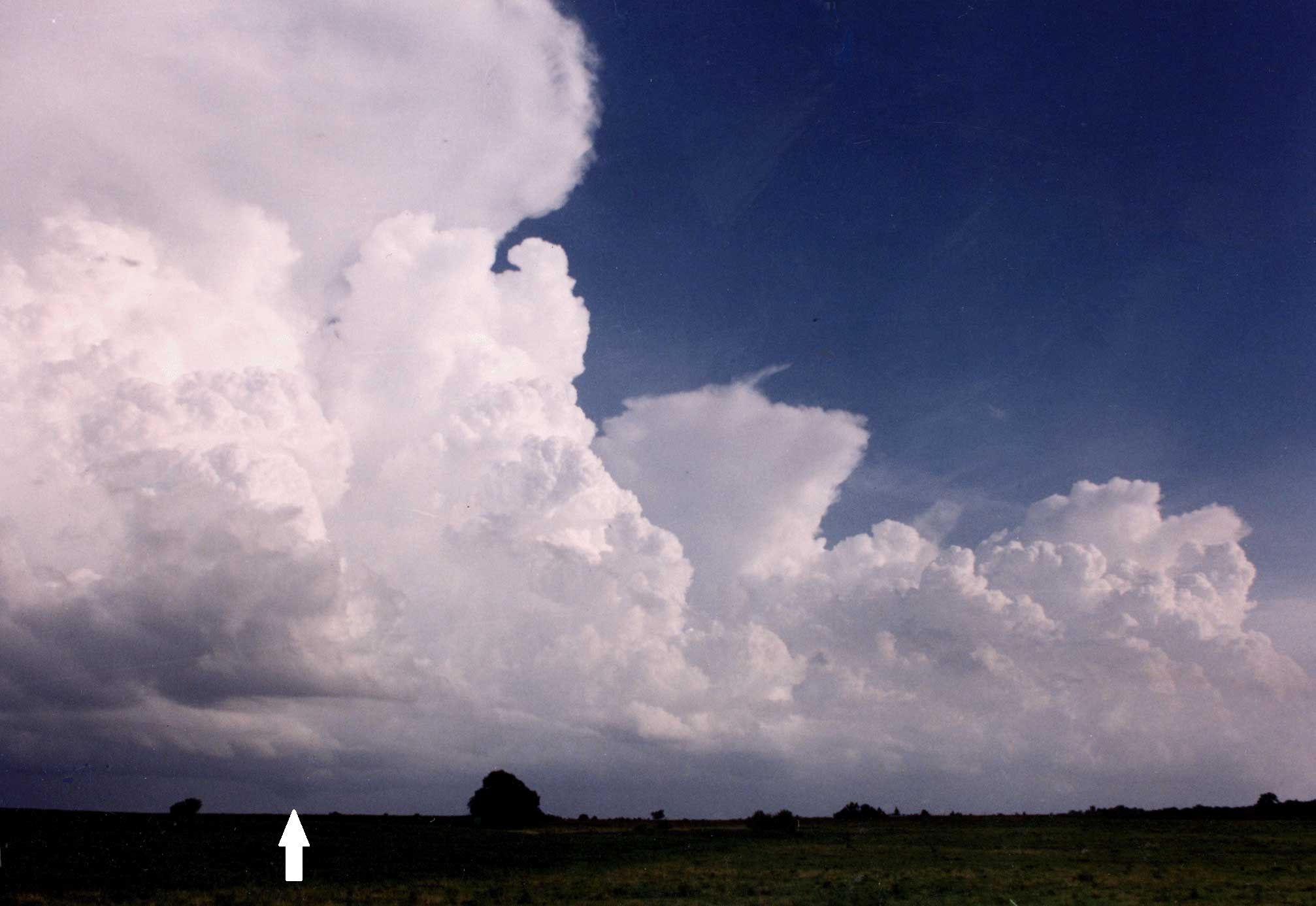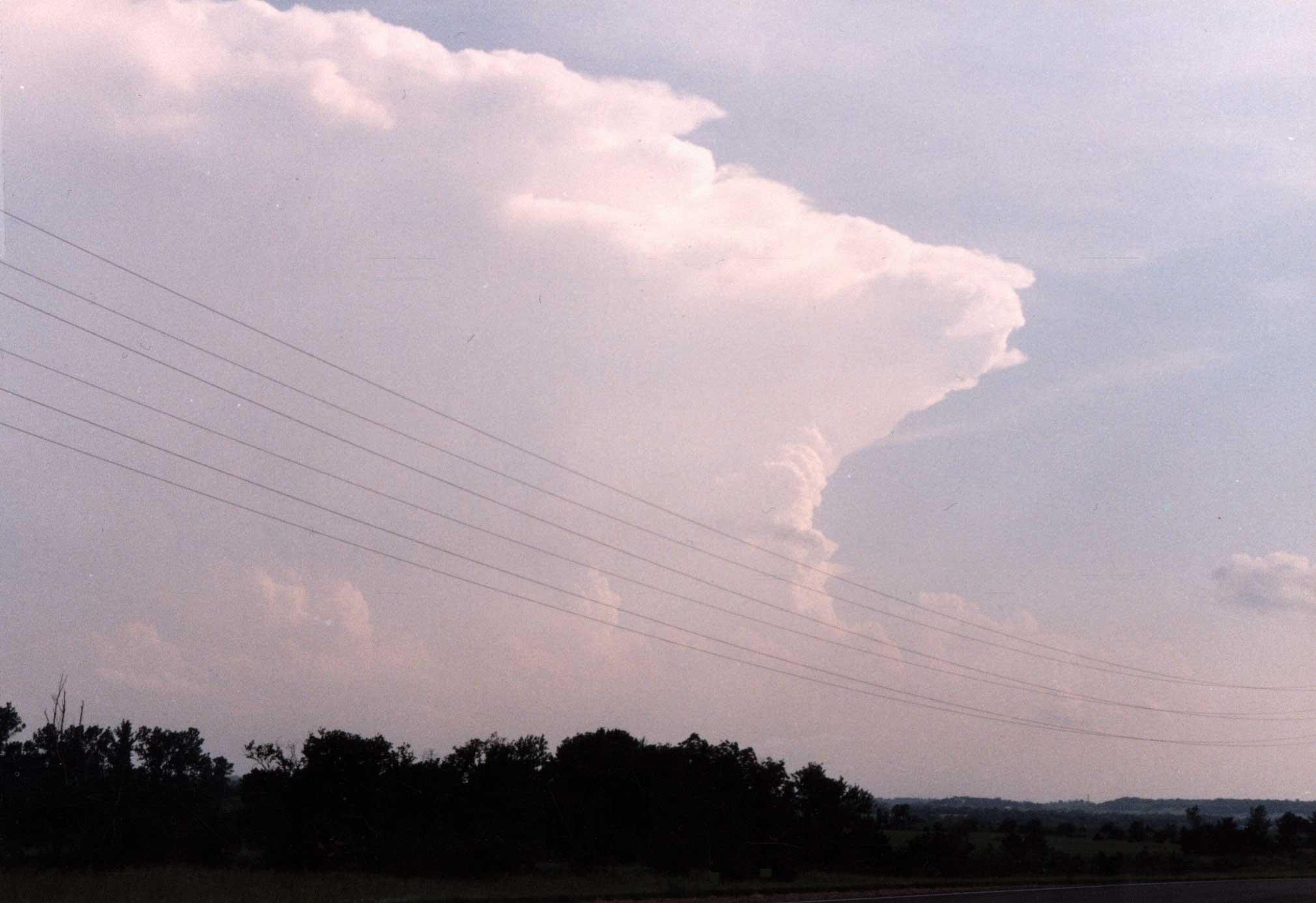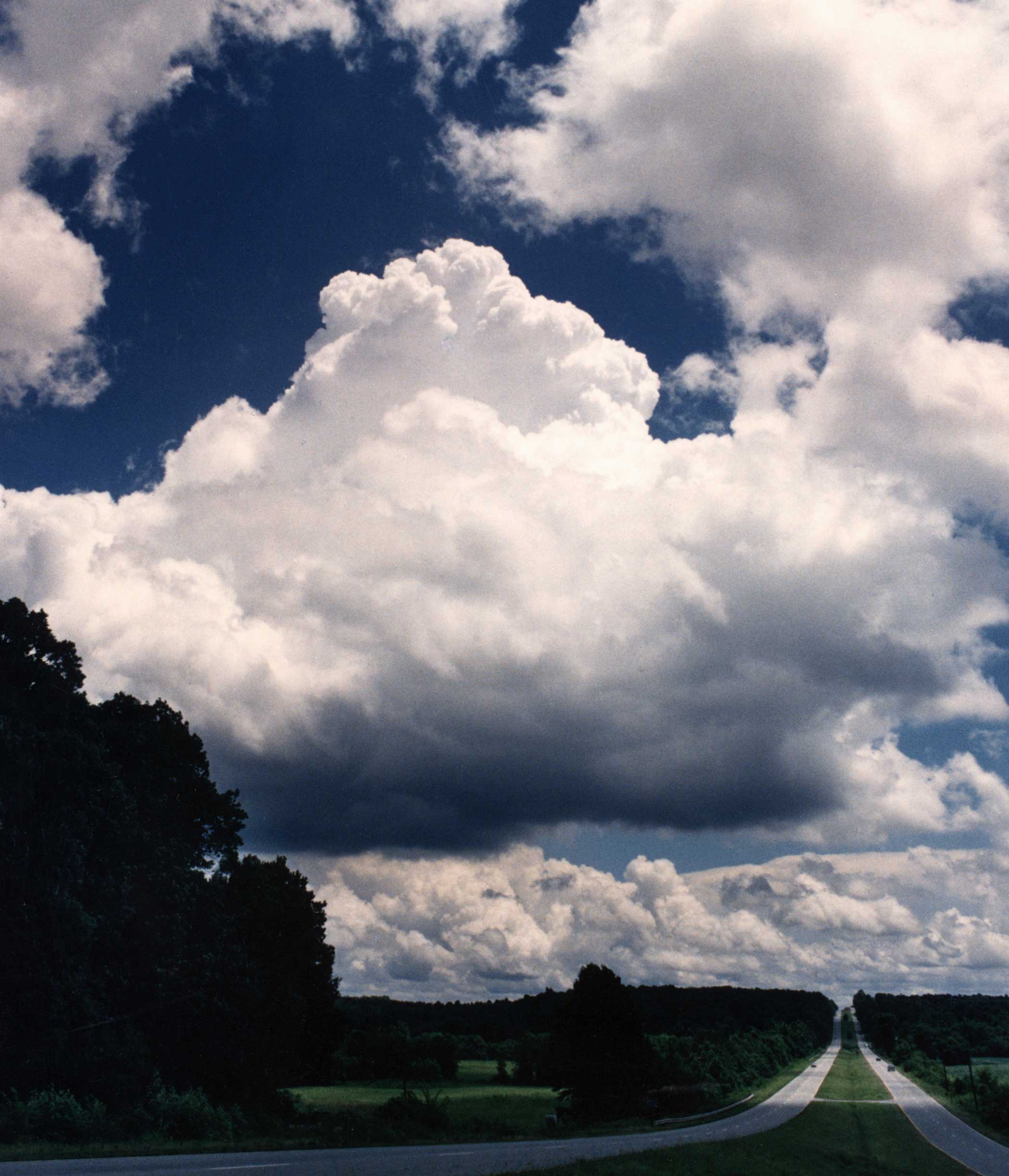Those Hazy Days of Summer:
Haze over the Central and Eastern United States
NOAA/NWS Storm Prediction Center
Norman, OK 73072
June 1993; updated April 2019
It's a July afternoon in New York City --- or perhaps Atlanta, Chicago, Dallas, Memphis, and St. Louis --- anywhere, really, east of the Rockies. The most recent cold front passed days ago. Since then, the air has once again become warm and humid, and the wind languid. The familiar blue of the sky has given way to a milky pall that masks distant views. Yes, it's just another hazy day of summer!
Because haze so frequently accompanies sultry summer weather in the East, Midwest, and South, it often is dismissed as a fact of life. Indeed, there is a natural component to haze, derived, in part, from the emissions of trees and other vegetation. But much of what we see as "haze" is, in fact, a form of diffuse air pollution and, as such, a cause for concern.
Although haze can affect many things, it is most noticeable for reducing air quality, especially visual range (visibility) and contrast. Sunrise and sunset colors lose luster in haze, while rainbows and haloes may disappear altogether (Figure 1).

Figure 1. The setting sun dimmed by a veil of dense, late-summer haze over
State College,
Pennsylvania.
Depending on its density and lighting, haze can sufficiently obscure the sky so as to hide weather hazards. For example, low-level cloud formations associated with tornadoes and severe convective winds are sometimes shrouded by haze (Figure 2).
 |
 |
Figure 2. Moderately distant, early-evening supercell storms as seen from the north-northwest on a haze-free day (left), and on a hazy one (right). Cloud-base lowering (wall cloud) near arrow in the left image was associated with a tornado shortly after the photograph was made; a tornado was occurring at the time of photography of the right image, but the wall cloud and tornado were both obscured by haze.
More significantly, haze can sufficiently impair visibility to pose a hazard to aviation. For example, haze may have been a factor in the fatal crash of a single-engine plane piloted by John F. Kennedy, Jr. off the coast of Massachusetts in July 1999. Studies also have linked the chemical components of haze to respiratory ailments in humans, and the reduction of visual acuity in haze to increased anxiety and depression. On the other hand, it is believed that the scattering of sunlight by haze may be sufficient to somewhat offset the potential warming effects of increasing concentrations of atmospheric greenhouse gases.
On a clear day you can't see forever
Haze is a favorite tool of landscape painters because the faded colors of distant, haze-shrouded views impart a sense of depth. In the United States, this effect arguably is most noticeable in the Blue Ridge and Great Smoky Mountains of the Appalachians. Indications are that these mountains likely were named for a natural haze derived from volatile gases emitted by various trees in the region. Prior to the industrial era, it is believed that the resulting bluish veil at worst reduced visibility to around 25 miles.
Today, however, nature's delicate blue haze rarely is seen. Visibility on a typical clear summer day over the Appalachians now is about 20 miles; on an average day, perhaps 7 or 8 miles. The "smoke" commonly seen over the Great Smokies today primarily is a suspension of tiny droplets of condensed pollution --- i.e., a vast, thin cloud of what is known as "wet haze." The adjective "wet" is used to distinguish droplet-bearing forms of haze from the "dry" forms of haze (such as the "Harmattan" of west Africa) that consist of dust.
Since the 1970s, research has shown that the primary constituent of haze droplets over the central and eastern United States is sulfuric acid. Much of the sulfuric acid may be traced to the release of sulfur dioxide gas during combustion of sulfur-containing coal in power generation, oil refining, and steel manufacturing. Sulfur dioxide emissions in this country are concentrated in a broad arc that extends from the upper Texas Gulf Coast through the lower and Mid-Mississippi Valleys to the lower Great Lakes, the Mid-Atlantic States, and southern New England.
Once in the atmosphere, sulfur dioxide tends to bond with oxygen, sometimes in oxidation reactions enhanced by sunlight (photooxidation), and sometimes in the presence of liquid water (as in the droplets of clouds of power-plant plumes). The net result of the chemical reactions is the formation of sulfates --- compounds of sulfur and oxygen. These sulfates may exist in either liquid or solid form. Liquid sulfates occur as droplets of sulfuric acid; the solids in the form of ammonium salts that readily form sulfuric acid with the addition of water.
Sulfate aerosols are hygroscopic; that is, they readily absorb water in the atmosphere, even when the relative humidity is as low as 60 or 70 percent. Thus, sulfate aerosols are excellent condensation nuclei. In even modestly moist surroundings, both liquid and solid aerosols grow as water molecules are drawn to their surfaces. In supersaturated air (where relative humidity exceeds 100 percent), sulfuric acid droplets might eventually reach a micrometer or so in diameter, at which point they suddenly enlarge at a faster rate and become readily visible as a cloud.
If the relative humidity remains somewhat lower, say near 70 percent, the droplets typically grow to only about a tenth of a micrometer in diameter --- about 100 times smaller than a typical cloud droplet --- and remain suspended in the air by turbulence. Many billions of such tiny droplets gathered together create the sky-obscuring veils we know as haze.
While tiny, sulfuric acid droplets are huge compared to air molecules. The droplets scatter or reflect sunlight a million times more effectively than air molecules. More importantly, unlike scattering by air molecules --- an effect that is strongly wavelength-dependent (that is, shorter wavelengths, like violet and blue, are scattered much more than longer wavelengths such as orange and red) scattering by haze droplets is not. As a result, a sky loaded with sulfate aerosols appears whitish instead of blue; haze reduces "spectral purity." In addition, because there is a net increase in the total number of particles in hazy air relative to clean air, the amount of direct sunlight that reaches the ground on a hazy day is reduced; that is, haze increases atmospheric extinction.
Haze typically is most prominent in the atmospheric boundary layer --- that is, in the layer of air extending upward from the surface a variable depth determined by the degree of vertical mixing present in the lower troposphere. Because the top of the boundary layer often is marked by a temperature inversion and a cessation of vertical transport from the surface, the upper edge of a haze layer often is quite sharp; this "haze horizon" is a familiar sight to airline passengers. Elevated haze layers do, however, also occur, especially downstream from regions where haze particles have been lofted beyond the boundary layer by cumulus clouds. Elevated haze also may appear on the poleward side of fronts, when there exists a component of motion toward the cooler air. In such instances, haze forming on the warm side of the boundary may be carried aloft, above a layer of colder, cleaner air at the surface.
Hanging around
Sulfate aerosols are not only small but also chemically stable. As a result, they settle only very slowly and can remain airborne for days. They can travel far from their origin when winds are strong and constant in direction.
Sulfates are primarily washed from the atmosphere by precipitation. Because they are good condensation nuclei, sulfate aerosols often comprise the clouds of developing storm systems. In such cases, the pollutants may travel many hundreds of miles before finally falling to the surface in the form of acid rain or snow. It therefore is not surprising that the haziest regions of the world, such as the eastern parts of the United States and China, also are the areas most plagued by acid rain.
Because the main sources of sulfur dioxide in the United States --- both man-made and natural --- lie east of the Rockies, and because of the prevailing westerly flow at mid-latitudes, the western United States is comparatively haze-free. However, nitrous oxide-based, photochemical smogs are common in the Los Angeles basin and beyond. In the East, hazy days are less common in south Florida and in northern New England than, say, over the Ohio valley or the interior South due to the more frequent incursions of haze-free tropical or polar air masses, respectively, into those regions. That sulfates rather than moisture alone largely are responsible for haze is demonstrated by the fact that when air of Caribbean or western Atlantic origin overspreads, say, the Mid-Atlantic region, the sky remains intensely blue and the air haze-free, despite its high boundary layer moisture content (Figure 3).

Figure 3. Moist air is not hazy without sulfates. The sky remains haze-free on a humid summer morning near Danville, Virginia, where a surge of air from the tropical Atlantic has displaced a hazy, sulfate-laden air mass of continental origin --- the type more commonly present over the region.
Other factors also conspire to make some parts of the country especially vulnerable to haze. Whereas much of the West is comparatively dry and continually refreshed by relatively clean air streams of recent Pacific origin, the East more often is traversed by "recycled" continental air. Especially during summer, when the semi-permanent, subtropical anticyclone known as the "Bermuda High" expands west across the region, the associated low-level flow becomes sluggish. Air in the boundary layer in such situations likely was most recently resident over the lower Mississippi or Ohio Valleys than the cleaner western Atlantic. At the same time, deep atmospheric transport typically reaches an annual minimum. Limited deep mixing, abundant sunshine, and increasing boundary layer moisture via evapotranspiration together create ideal conditions for the formation, growth, and accumulation of haze aerosols. Sometimes the extensive haze that develops under such conditions can re-visit the same area twice in one week (Figure 4).

Figure 4. Day-to-day evolution of a classic mid-summer haze event that twice affects the lower Ohio Valley in conjunction with a weak cold front and the westward extension of the "Bermuda High." Haze areas (visual range less than 10 km or 6 miles) shaded grey, with 850 mb (roughly 1500 m or 5000 ft) streamlines in top row, and surface isobars and fronts at bottom. (From Wolff et al. 1981).
Thanks to the adoption of stricter air pollution standards and to the reduction of industrial emissions in the Midwest and East, sulfur dioxide concentrations --- and haze --- have somewhat decreased over those regions in the past two decades. But haze traced to Los Angeles area vehicle emissions and to power plant sulfate plumes appears to be increasing over the Southwest. Visibility reductions due to haze have become especially notable in the national parks of Arizona and Utah. In addition, haze has been increasing in rapidly developing parts of the world such as China, India, and Southeast Asia --- and some of this haze reaches the United States.
Although the threats posed by haze typically are not as immediate as those associated with hurricanes, tornadoes, and flash floods, the overall impact of the phenomena is nonetheless significant. Because of this, it is worthwhile to better understand haze and recognize its significance.
Further reading
The preceding paragraphs have provided only a brief introduction to the chemistry and meteorology of haze. The following references offer additional information:
Ball, R. J., and G. D. Robinson, 1982: The origin of haze in the central United States and its effect on solar radiation. J. Appl. Meteor., 21, 171-188.
Corfidi, S. F., 1996: Haze over the Central and Eastern United States. Nat. Wea. Dig., 20
, 2-14
(available here: http://spcwebsite.spc.noaa. Malm, W. C., 2000: Introduction to Visibility. Cooperative Institute for Research in the Atmosphere
(CIRA), Colorado State University, 68 pp.
Schichtel, B. A., and R. B. Husar, S. R. Falke, and W. E. Wilson, 2001: Haze trends over the United States,
1980-1995. Atmos. Environ., 35, 5205-5210.
Wolff, G. T., N. A. Kelly and M. A. Ferman, 1981: On the sources of summertime haze in the eastern
United States. Science, 211, 703- 705.
A useful site for monitoring haze and other atmospheric aerosols on a daily basis is the
"Smog Blog" of the U.S. Air Quality site of
the University of Maryland, Baltimore County.